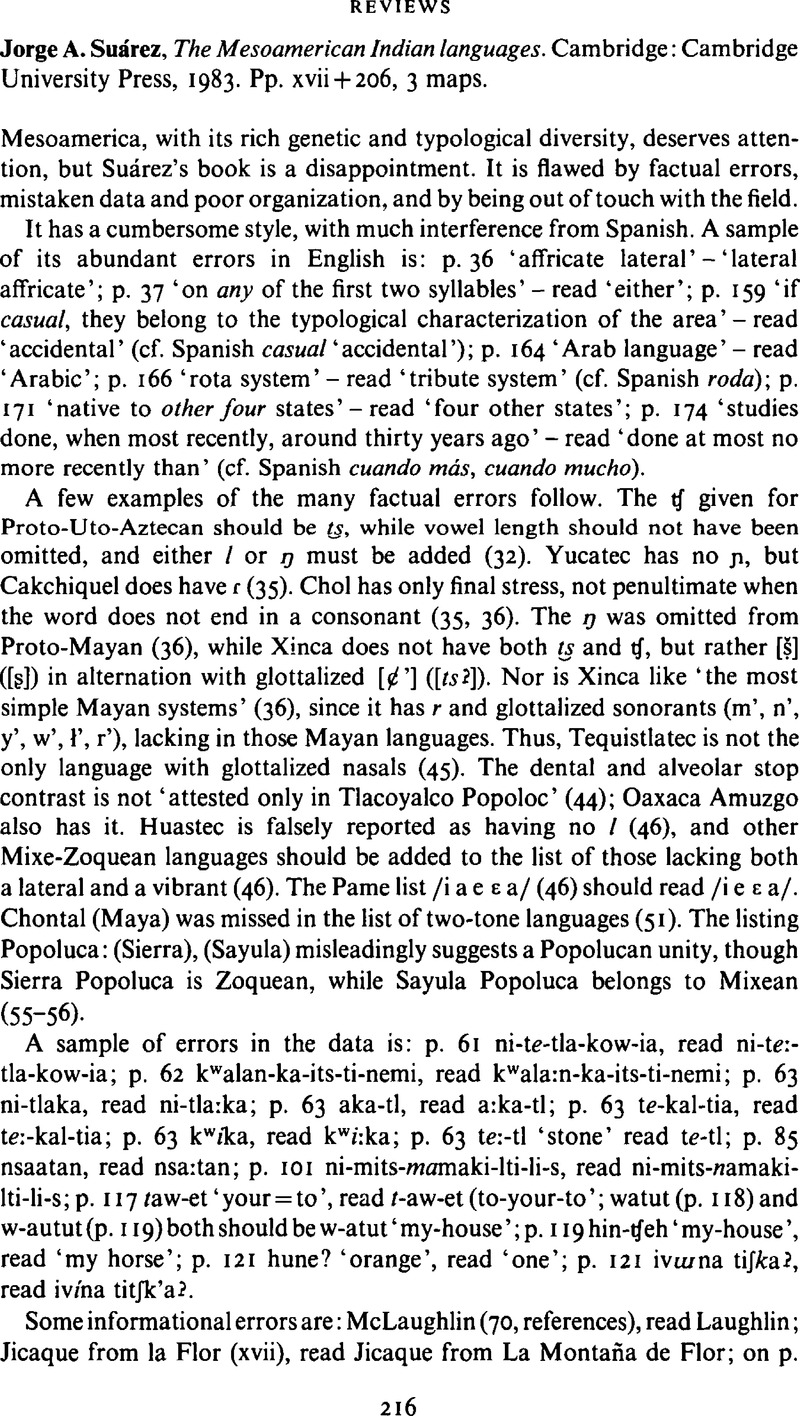No CrossRef data available.
Article contents
Jorge A. Suárez, The Mesoamerican Indian languages. Cambridge: Cambridge University Press, 1983. Pp. xvii + 206, 3 maps.
Published online by Cambridge University Press: 28 November 2008
Abstract
An abstract is not available for this content so a preview has been provided. Please use the Get access link above for information on how to access this content.

- Type
- Reviews
- Information
- Copyright
- Copyright © Cambridge University Press 1985
References
REFERENCES
Bricker, Victoria R. (1981). The source of the ergative split in Yucatec Maya. Journal of Mayan Linguistics 2.2. 83–127.Google Scholar
Brown, Cecil H. & Witkowski, Stanley R. (1979). Aspects of the phonological history of Mayan-Zoquean. UAL 45. 34–47.Google Scholar
Bruce, Roberto D. (1974). El libro de Chan K'in. Colección científica, 12. Mexico. Instituto Nacional de Antropología e Historia.Google Scholar
Burns, Allan F. (1983). Oral literature of the Yucatec Maya. Austin: University of Texas Press.Google Scholar
Campbell, Lyle. (1973). The philological documentation of a variable rule in the history of Pokom and Kekchi. IJAL 39. 133–134.Google Scholar
Campbell, Lyle. (1974). Theoretical implications of Kekchi phonology. IJAL 40. 269–278.Google Scholar
Campbell, Lyle. (1977). Quichean linguistic prehistory. University of California Publications in Linguistics, 81. Los Angeles: University of California Press.Google Scholar
Campbell, Lyle. (1978a). Distant genetic relationship and diffusion: a Mesoamerican perspective. Proceedings of the International Congress of Americanists 52. 595–605. Paris.Google Scholar
Campbell, Lyle. (1978b). Quichean prehistory: linguistic contributions. In England, Nora C. (ed.) Papers in Mayan Linguistics. Columbia: University of Missouri Department of Anthropology. 25–54.Google Scholar
Campbell, Lyle. (1978c). Quichean linguistics and philology. In McCormack, William & Wurm, Stephen (eds). World anthropology: approaches to language, anthropological issues. Mouton: The Hague. 223–233.CrossRefGoogle Scholar
Campbell, Lyle & Kaufman, Terrence. (1980). On Mesoamerican linguistics. American Anthropologist 82. 850–857.CrossRefGoogle Scholar
Campbell, Lyle & Kaufman, Terrence (1983). Mesoamerican historical linguistics and distant genetic relationship: getting it straight. American Anthropologist 85. 362–372.CrossRefGoogle Scholar
Campbell, Lyle. (1984). Linguistic diffusion and Mesoamerican prehistory. Unpublished manuscript, 640 pp. SUNY, Albany, N.Y.Google Scholar
Campbell, Lyle, Kaufman, Terrence & Smith-Stark, Tom (1984). Mesoamerica as a linguistic area. Manuscript submitted for publication.Google Scholar
Campbell, Lyle & Langacker, Ronald (1978). Proto-Aztecan vowels (three parts). IJAL 44. 85–102, 197–210, 262–279.Google Scholar
Carmack, Robert (1973). Quichean civilization: the ethnohistoric, ethnographic, and archaeological sources. Los Angeles: University of California Press.Google Scholar
Dakin, Karen (1981). The characteristics of a Nahuatl Lingua franca. In Nahuatl studies in memory of Fernando Horcasitas. Texas Linguistics Forum 18, Frances, Karttunen (ed.), 55–67. Austin: Department of Linguistics, University of Texas.Google Scholar
Dayley, Jon, P. (1981). Voice and ergativity in Mayan languages. Journal of Mayan Linguistics 2. 2. 3–82.Google Scholar
Edmonson, Munro S. (1968). Metafora maya en literatura y en arte. Verhandlungen des XXXVII Internationalen Amerikanistenkongresses, 2. 37–50. Stuttgart.Google Scholar
Edmonson, Munro S. (1971). The book of counsel: the Popol Vuh of the Quiche Maya of Guatemala. Middle American Research Institute, publication 35. New Orleans: Tulane University.Google Scholar
EdmonsonMunro, S. Munro, S. (1982). The ancient future of the Itza: the book of Chilam Balam of Tizimin. Austin: University of Texas Press.Google Scholar
Fought, John G. (1972). Chorti (Mayan) texts. Philadelphia: University of Pennsylvania Press.Google Scholar
Gossen, Gary H. (1974). Chamulas in the world of the sun: time and space in a Maya oral tradition. Cambridge, Mass.: Harvard University Press.Google Scholar
Justeson, John, Norman, William, Campbell, Lyle & Kaufman, Terrence. (1984). The foreign impact on lowland Mayan language and script. Middle American Research Institute, Publication 53. New Orleans: Tulane University.Google Scholar
Kaufman, Terrence (1974). Idiomas de Mesoamérica. Seminario de Integración Social Guatemalteca Publication 33. Guatemala.Google Scholar
Kaufman, Terrence (1978). Archaeological and linguistic correlations in Mayaland and associated areas of Meso-America. World Archaeology 8. 101–18.CrossRefGoogle Scholar
Larsen, T. W. & Norman, W. M. (1979). Correlates of ergativity in Mayan grammar. In Plank, Frans (ed.) Ergativity: towards a theory of grammatical relations. Academic Press: New York. 347–370.Google Scholar
Lowe, Gareth W. (1977). The Mixe-Zoque as competing neighbors of the early Lowland Maya. In Adams Richard, E. W. (ed.) The origins of Maya civilization. Albuquerque: University of New Mexico Press. 197–248.Google Scholar
Mondloch, James (1983). Una comparación entre los estilos de habla del quiché moderno y los encontrados en el Popol Vuh. In Carmack, Robert & Santos, Francisco Morales (eds.) Nuevas perspectivas sobre el Popol Vuh. Guatemala: Piedra Santa. 87–108.Google Scholar
Muntzel, Martha C. (1982). La applicación de un modelo generativo a la fonologia del tlahuica (ocuilteco). Colección Científica, 118. Mexico: Instituto Nacional de Antropología e Historia.Google Scholar
Norman, William (1980). Grammatical parallelism in Quiche ritual language. Papers of the Berkeley Linguistics Society 6. 387–399.Google Scholar
Norman, William (1983). Paralelismo gramatical en el lenguaje ritual quiché. In Carmack, Robert & Santos, Francisco Morales (eds.) Nuevas perspectivas sobre el Popol Vuh. Guatemala: Piedra Santa. 109–122.Google Scholar
Normal, William & Campbell, Lyle (1978). Toward a Proto-Mayan syntax: a comparative perspective on grammar. In England, Nora C. (ed.), Papers in Mayan linguistics. Columbia: University of Missouri Department of Anthropology. 136–156.Google Scholar
Seler, Eduard (1887). Das Konjugations System der Mayasprachen. Berlin. Unger Grimm. (Also in, 1902–1923. Gesammelte Abhandlungen zur Amerikanischen Sprache und Altertumskunde 1, 65–126. Berlin: A. Ascher.)Google Scholar
Shaw, Mary (ed.) (1971). According to our ancestors: folk texts from Guatemala and Honduras. Norman Oklahoma: Summer Institute of Linguistics.Google Scholar
Smailus, Ortwin (1975). El maya-chontal de Acolán: análisis lingüístico de un documento de los años 1610–1612. (Centro de Estudios Mayas, Cuaderno 9). Mexico: Universidad Nacional Autónoma de México.Google Scholar
Stone, Doris (1972). Pre-Columbian man finds Central America. Cambridge, Mass.: Peabody Museum Press.Google Scholar
Vázquez, Soto, Verónica, Guadalupe (1977). Fonología generativa del náhuatl clásico. Licentiate's thesis, Escuela Nacional de Antropología e Historia. Mexico.Google Scholar




